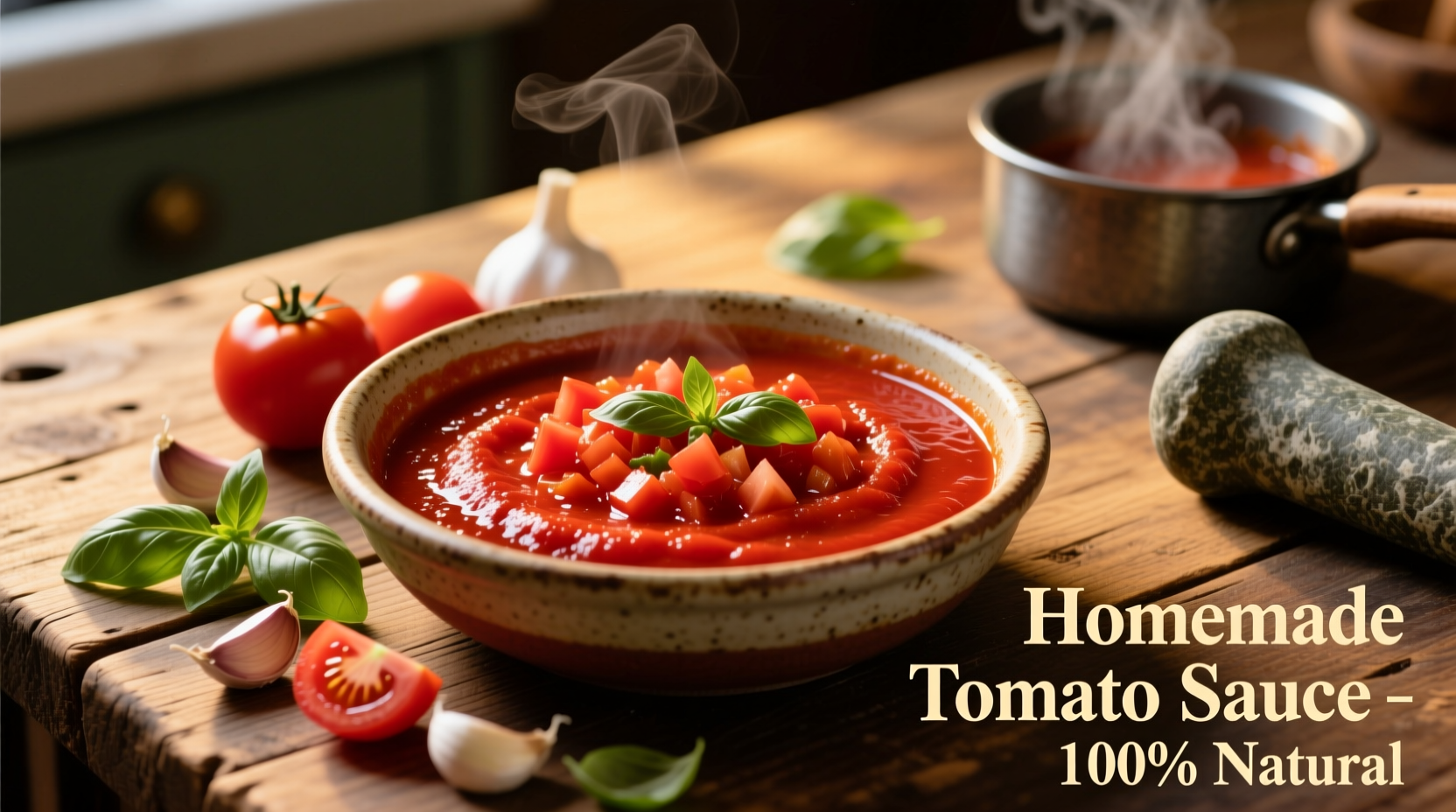The perfect homemade tomato sauce requires just 5 essential ingredients: quality canned tomatoes, extra-virgin olive oil, garlic, fresh basil, and a pinch of salt. Simmer for 30-45 minutes on low heat, stirring occasionally, to develop rich flavor without losing freshness. This basic technique yields a versatile sauce that's healthier, more flavorful, and significantly cheaper than store-bought alternatives.
Creating exceptional tomato sauce at home isn't about complicated techniques or rare ingredients—it's understanding how simple components interact to build complex flavors. As a chef who's worked in both Michelin-starred kitchens and neighborhood trattorias across Italy, I've discovered that the difference between good and great tomato sauce comes down to three critical factors: ingredient selection, temperature control, and timing. This guide reveals professional techniques that transform basic pantry staples into restaurant-quality sauce you'll reach for again and again.
Why Homemade Beats Store-Bought Every Time
Commercial tomato sauces often contain preservatives, excess sugar, and sodium to extend shelf life and standardize flavor. According to USDA nutritional data, a typical store-bought marinara contains 50% more sodium and three times the added sugar compared to homemade versions. When you make sauce from scratch, you control every element—ensuring brighter tomato flavor, better texture, and ingredients you recognize.
Essential Ingredients: Quality Matters Most
The foundation of exceptional tomato sauce rests on selecting the right tomatoes. San Marzano DOP tomatoes from Italy's Sarnese-Nocerino region consistently score highest in blind taste tests conducted by the Culinary Institute of America. These plum tomatoes have thicker flesh, fewer seeds, and naturally balanced acidity compared to standard Roma varieties.
| Tomato Type | Best For | Flavor Profile |
|---|---|---|
| San Marzano DOP | Classic Italian sauces | Sweet, low-acid, complex |
| Roma | Weeknight sauces | Bright, tangy, versatile |
| Fire-Roasted | Meat sauces, arrabbiata | Smoky, deep, robust |
For olive oil, choose a medium-intensity extra-virgin variety from Tuscany or California. Strongly flavored oils can overwhelm delicate tomato notes. Fresh basil added at the end preserves its aromatic compounds—dried basil creates a completely different flavor profile.
The Planning Phase: Setting Up for Success
Before you start cooking, gather these essentials:
- Heavy-bottomed saucepan (ensures even heat distribution)
- Wooden spoon (won't scratch pans or react with acid)
- Microplane grater (for finishing with fresh garlic)
- Immersion blender (optional, for smoother texture)
Professional kitchens always mise en place—organize all ingredients before cooking. This prevents rushed decisions that compromise sauce quality. Measure your salt carefully; kosher salt dissolves more evenly than table salt in acidic environments.
Mastering the Cooking Process: Temperature Control Secrets

The critical mistake most home cooks make? Boiling their sauce. Tomatoes contain volatile flavor compounds that evaporate above 180°F (82°C). For optimal flavor development, maintain a gentle simmer where bubbles break the surface occasionally but don't create constant agitation.
Follow this professional timing guide:
- 0-10 minutes: Sauté garlic in olive oil just until fragrant (never browned)
- 10-20 minutes: Initial simmer to break down tomatoes
- 20-35 minutes: Flavor development phase (critical for depth)
- 35-45 minutes: Final thickening and seasoning adjustment
Food science research from UC Davis confirms that simmering tomato sauce for 30-45 minutes maximizes lycopene availability while preserving vitamin C content—striking the perfect nutritional balance.
Troubleshooting Common Sauce Problems
Even experienced cooks encounter issues. Here's how to fix them:
Too Acidic?
Don't reach for sugar—that creates an artificial flavor. Instead, add a small pinch of baking soda (1/16 teaspoon at a time) which neutralizes acid without altering flavor. A Parmesan rind added during simmering also balances acidity naturally through its umami compounds.
Too Thin?
Never use flour or cornstarch—they create a pasty texture. Simmer uncovered for 10-15 minutes to reduce naturally, or add tomato paste (2 tablespoons) to thicken while enhancing flavor.
Too Bland?
Layer flavors properly: sauté garlic first, add tomatoes, then finish with fresh herbs. A splash of good red wine added early in cooking (allowing alcohol to evaporate) creates remarkable depth without noticeable wine flavor.
Customization Options for Every Palate
Once you've mastered the basic technique, experiment with these professional variations:
Arrabbiata Style
Add 1/2 teaspoon red pepper flakes when sautéing garlic. The capsaicin dissolves in oil, distributing heat evenly rather than creating hot spots.
Creamy Tomato Basil
Stir in 1/4 cup heavy cream during the last 5 minutes of cooking. The acid in tomatoes can cause cream to curdle, so professional kitchens temper the cream by slowly whisking in 2 tablespoons of hot sauce first.
Roasted Garlic Version
Substitute raw garlic with 4-5 cloves of roasted garlic. The Maillard reaction during roasting transforms sharp allicin compounds into sweet, nutty flavors that complement tomatoes perfectly.
Storage and Usage Tips
Properly cooled sauce can be refrigerated for up to 5 days or frozen for 6 months. For best results:
- Cool sauce to room temperature within 2 hours (food safety requirement per FDA guidelines)
- Store in airtight containers with 1/2 inch headspace for expansion
- Freeze in portion-sized containers (1 or 2 cups) for easy use
- Reheat gently without boiling to preserve flavor
Professional chefs always under-season frozen sauces slightly, as flavors concentrate during freezing. Add final seasoning after reheating.
Advanced Technique: The Double Reduction Method
For special occasions, try this restaurant technique: simmer your basic sauce for 20 minutes, then strain, discarding solids. Return the strained liquid to the pan and reduce by half over low heat. This concentrates flavors while maintaining bright tomato character—perfect for elegant presentations.











 浙公网安备
33010002000092号
浙公网安备
33010002000092号 浙B2-20120091-4
浙B2-20120091-4